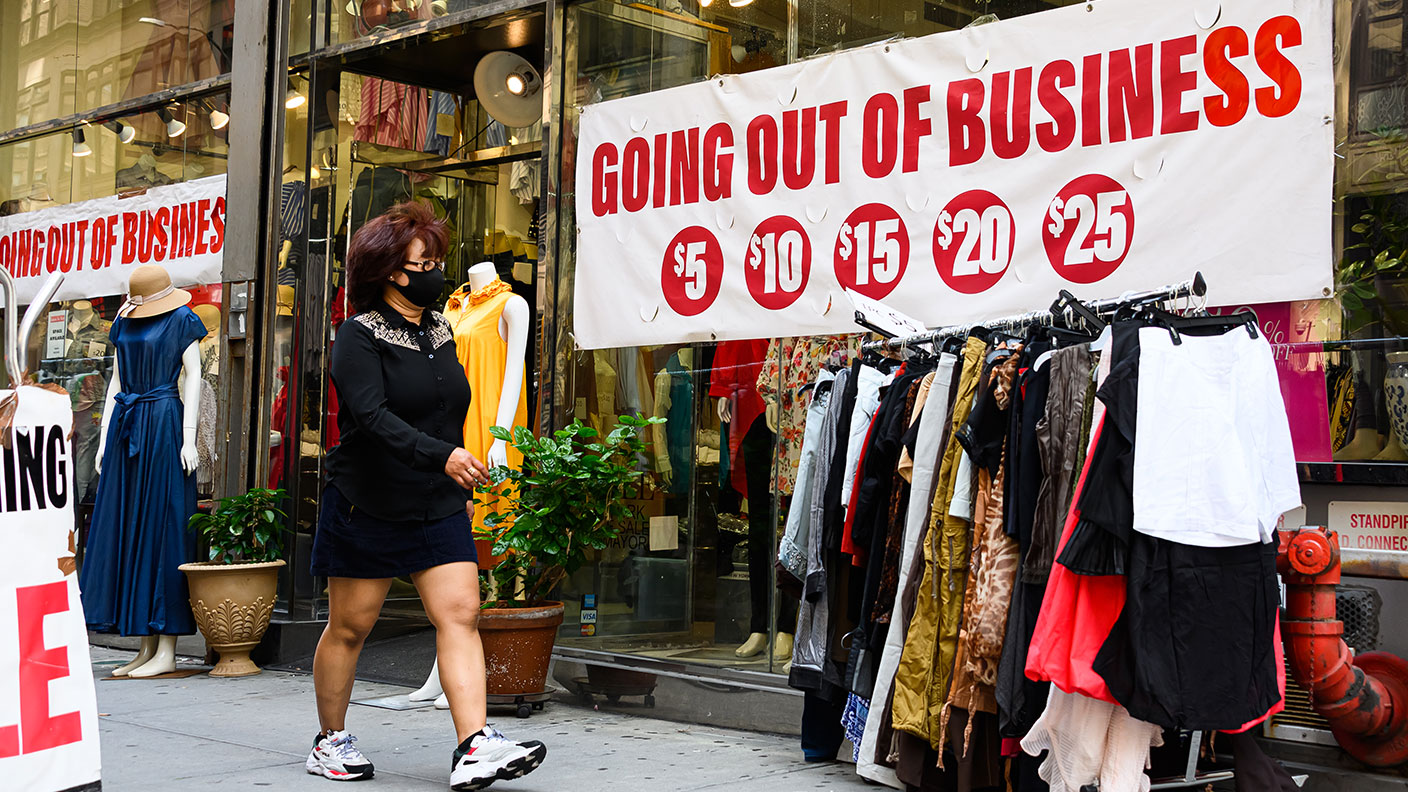Markets believe that bankruptcy has been abolished – that’s not a good thing
The gap between corporate and government debt is collapsing, with investors demanding very little extra yield for taking on the risk of bankruptcy. That could pose a problem, says John Stepek. Here’s why.


There’s something quite interesting going on in corporate bond markets.
As the FT reports, the gap (or “spread”) between the yield on corporate bonds and that of US Treasuries (US government debt) has fallen to its lowest level in over a decade.
What does that mean?
MoneyWeek
Subscribe to MoneyWeek today and get your first six magazine issues absolutely FREE

Sign up to Money Morning
Don't miss the latest investment and personal finances news, market analysis, plus money-saving tips with our free twice-daily newsletter
Don't miss the latest investment and personal finances news, market analysis, plus money-saving tips with our free twice-daily newsletter
Keep reading, and I’ll tell you.
The gap between corporate and government debt is collapsing
US Treasuries are US government IOUs. So the yield on them – the interest rate – is the cost of borrowing for the US government.
The US government is generally deemed to be the most creditworthy borrower in the world, partly because it is backed by the most powerful economy in the world, and partly because the US Treasury market is so large and active (which means you’ll never have any difficulty selling a US Treasury).
As a result, the yield on the ten-year Treasury (what it costs the US government to borrow money for ten years) is sometimes known as the “risk-free rate”. (All of these terms are, of course, “all else being equal”. But let’s not worry about that for today.)
Right. So what’s interesting about all this?
One way to measure confidence among investors in economic growth and the like is to look at the gap between what it costs the US to borrow and what it costs companies to borrow. Unlike the US (which can always repay its debts with debased currency if it really wants to, though that would cause a lot of other problems), a company can go bankrupt.
That means investors should demand a higher yield on corporate debt relative to US government debt, to cover them for this extra risk.
What’s happening right now is that investors are demanding very little extra yield for taking bankruptcy risk. And we’re not just talking here about massive multinationals with little chance of going bust. We’re talking about “high-yield” or “junk” borrowers too – companies usually deemed at high risk.
So if investors aren’t demanding much extra yield for holding the debt of higher-risk companies, then what does that imply? In short, it implies that these companies have become more credit-worthy.
Why would high-risk companies have become more creditworthy? I mean, the clue is in the name “junk” debt. That’s the whole point of the asset class in many ways: it’s higher risk, and therefore higher reward.
But right now, junk debt is trading more like Greek sovereign bonds did relative to German Bunds a couple of years before the eurozone sovereign debt crisis. They were effectively seen as having virtually identical credit risk.
And bear in mind that this is in the aftermath of a global pandemic and epic (if brief) recession. Have companies really become more creditworthy?
You can argue that they have. You can argue that this is all happening because the economy is expected to grow fast, reducing bankruptcy risk. But that’s only if you’re trying to put a narrowly “rational” spin on it.
The reality is that markets believe that bankruptcy has been abolished.
Bankruptcy has effectively been abolished – or at least, markets think so
Why would they think that?
Well, the Federal Reserve has crossed many a Rubicon since 2008. But in 2020, it surpassed itself by agreeing to buy corporate debt of every flavour, including junk bonds, in order to calm financial markets down at the height of the coronavirus panic.
Now you might think they did the right thing. I’m in two minds about it. I agree entirely that having a financial market crisis on top of a global pandemic would have been terrible timing. But it set a really dangerous precedent.
You see, now the market knows what the next “emergency” move is. Quantitative easing (QE – printing money to buy sovereign debt) was an emergency measure when it was initially put in place after 2008. It’s still here.
But more importantly, it’s also part of the toolkit. Everybody knows that central banks are now happy to print money to buy government debt. They know that’s a “go-to” move when markets panic.
And that’s a bit of a problem. And it’s where I think the Greek/German government debt example is quite pertinent. Before the eurozone crisis, investors made little distinction between Greek and German debt. You bought Greek debt because it yielded a tiny bit more for what you assumed was effectively the same credit risk.
When the crisis hit, it turned out that Germany wasn’t actually prepared to stand behind Greek sovereign debt (not without a fight anyway).
A similar thing happened with mortgage-backed securities in the US. Investors bought them because they assumed they were effectively US Treasury debt, just with a little more yield.
Now, although it’s not being articulated to the same extent, the entire spectrum of corporate debt is being treated in a very similar manner.
Will investors get a nasty surprise when the Fed’s will to prop up these companies is next tested, just as investors in Greek debt and mortgage-backed securities were shocked when their assumptions were tested?
I don’t know. I’m not sure that the Fed has the stomach to allow anything like that to happen. As John Authers points out for Bloomberg, this is already a form of financial repression. And there’s a good chance it will just continue.
That has implications for the short term. But it has pretty grim consequences for the longer term. I’ve written more about those in MoneyWeek magazine this week. You can get your first six issues free here if you’re not already a subscriber.
But one thing I’d note, as the market tries to work out what the Fed’s little hawkish surprise meant on Wednesday, is that all of this implies that regardless of what happens to inflation, the Fed is going to have to keep interest rates low.
Get the latest financial news, insights and expert analysis from our award-winning MoneyWeek team, to help you understand what really matters when it comes to your finances.
John Stepek is a senior reporter at Bloomberg News and a former editor of MoneyWeek magazine. He graduated from Strathclyde University with a degree in psychology in 1996 and has always been fascinated by the gap between the way the market works in theory and the way it works in practice, and by how our deep-rooted instincts work against our best interests as investors.
He started out in journalism by writing articles about the specific business challenges facing family firms. In 2003, he took a job on the finance desk of Teletext, where he spent two years covering the markets and breaking financial news.
His work has been published in Families in Business, Shares magazine, Spear's Magazine, The Sunday Times, and The Spectator among others. He has also appeared as an expert commentator on BBC Radio 4's Today programme, BBC Radio Scotland, Newsnight, Daily Politics and Bloomberg. His first book, on contrarian investing, The Sceptical Investor, was released in March 2019. You can follow John on Twitter at @john_stepek.
-
 Rightmove: Biggest January rise in property asking prices in 25 years
Rightmove: Biggest January rise in property asking prices in 25 yearsThe traditional Boxing Day bounce and post-Budget positivity combined to create a 2.8% jump in property asking prices, data suggests
-
 PayPoint: A promising stock for income-seekers
PayPoint: A promising stock for income-seekersPayPoint, a household name across Britain, is moving away from its traditional roots toward a digital future. Investors after a steady income should buy in
-
 Halifax: House price slump continues as prices slide for the sixth consecutive month
Halifax: House price slump continues as prices slide for the sixth consecutive monthUK house prices fell again in September as buyers returned, but the slowdown was not as fast as anticipated, latest Halifax data shows. Where are house prices falling the most?
-
 Rents hit a record high - but is the opportunity for buy-to-let investors still strong?
Rents hit a record high - but is the opportunity for buy-to-let investors still strong?UK rent prices have hit a record high with the average hitting over £1,200 a month says Rightmove. Are there still opportunities in buy-to-let?
-
 Pension savers turn to gold investments
Pension savers turn to gold investmentsInvestors are racing to buy gold to protect their pensions from a stock market correction and high inflation, experts say
-
 Where to find the best returns from student accommodation
Where to find the best returns from student accommodationStudent accommodation can be a lucrative investment if you know where to look.
-
 The world’s best bargain stocks
The world’s best bargain stocksSearching for bargain stocks with Alec Cutler of the Orbis Global Balanced Fund, who tells Andrew Van Sickle which sectors are being overlooked.
-
 Revealed: the cheapest cities to own a home in Britain
Revealed: the cheapest cities to own a home in BritainNew research reveals the cheapest cities to own a home, taking account of mortgage payments, utility bills and council tax
-
 UK recession: How to protect your portfolio
UK recession: How to protect your portfolioAs the UK recession is confirmed, we look at ways to protect your wealth.
-
 Buy-to-let returns fall 59% amid higher mortgage rates
Buy-to-let returns fall 59% amid higher mortgage ratesBuy-to-let returns are slumping as the cost of borrowing spirals.
